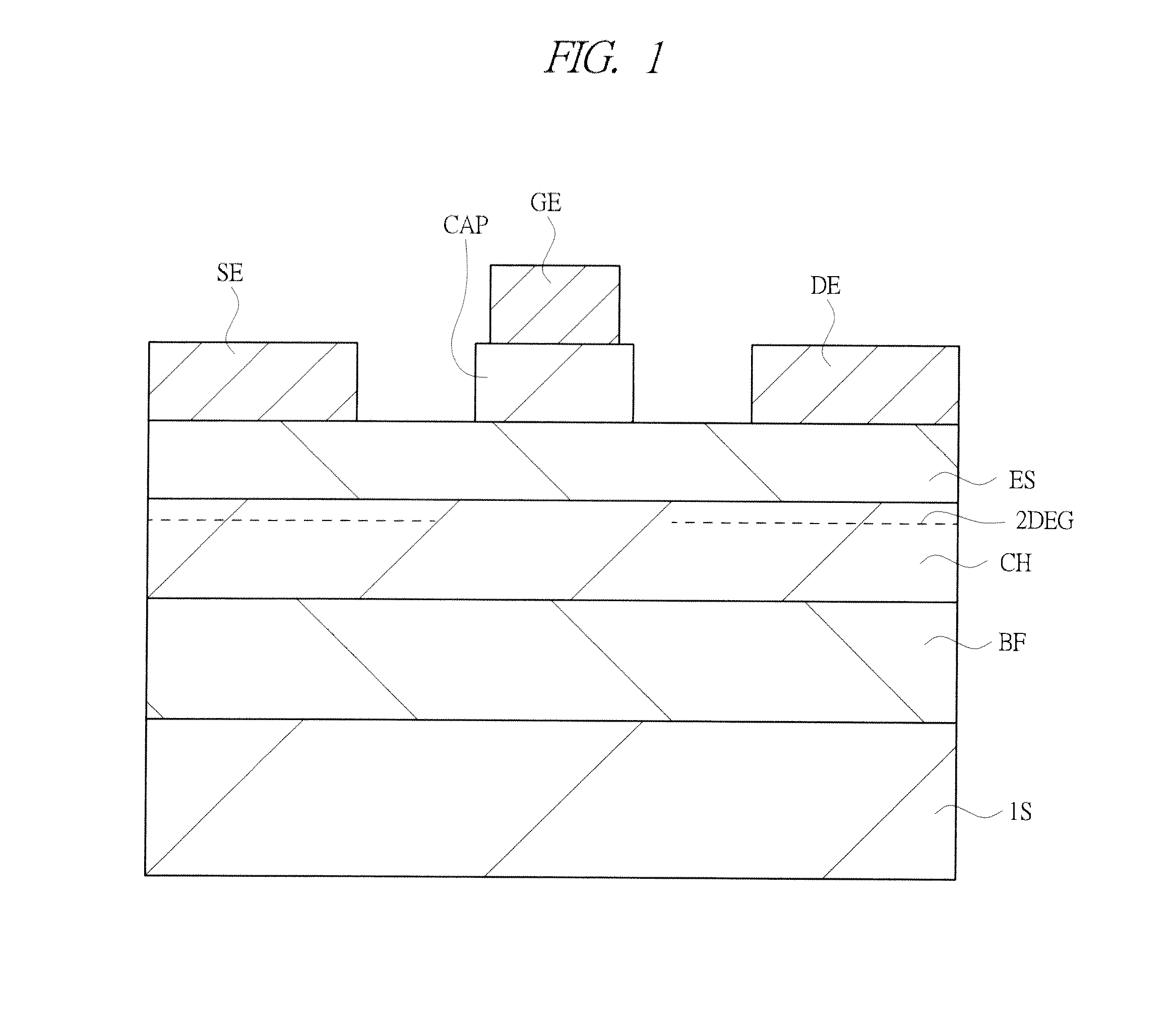Semiconductor device and method of manufacturing the same
a technology of semiconductors and semiconductors, applied in the direction of semiconductor devices, basic electric elements, electrical appliances, etc., can solve the problems of gate leakage current flowing, the performance of high electron mobility transistors to degrade, and the difficulty of reducing on-resistan
- Summary
- Abstract
- Description
- Claims
- Application Information
AI Technical Summary
Benefits of technology
Problems solved by technology
Method used
Image
Examples
first embodiment
Feature of First Embodiment
[0081]A feature in the first embodiment lies in that the spacer layer SP1 whose band gap is larger than the band gap of the electron supply layer ES1 is provided between the channel layer CH1 and the electron supply layer ES1, as shown in FIGS. 4 and 5. Thereby, due to the fact that the band gap of the spacer layer SP1 is large, a high potential barrier (electron barrier) is formed in the vicinity of the interface between the channel layer CH and the electron supply layer ES1. That is, a higher potential barrier is formed when the spacer layer SP1 is provided than when the spacer layer SP1 is not provided. As a result, according to the high electron mobility transistor in the first embodiment, the high potential barrier significantly suppresses the gate leakage current. Therefore, according to the high electron mobility transistor in the first embodiment, the maximum carrier concentration of the two-dimensional electron gas accumulated in the channel layer...
second embodiment
Feature of the Second Embodiment
[0128]FIG. 18 is a sectional view showing the configuration of a high electron mobility transistor in a second embodiment. In FIG. 18, the same reference numerals as in FIG. 4 denote the same contents in FIG. 4, and the second embodiment differs from the first embodiment in the composition of a spacer layer SP2 and the composition of an electron supply layer ES2. That is, a feature of the second embodiment lies in that the spacer layer SP2 is composed of aluminum indium nitride (AluIn1-uN), and the electron supply layer ES2 is composed of aluminum gallium nitride (AlvGa1-vN).
[0129]Here, the band gap of the spacer layer SP2 composed of aluminum indium nitride (AluIn1-uN) is larger than the band gap of the electron supply layer ES2 composed of aluminum gallium nitride (AlvGa1-vN). Thereby, due to the fact that the band gap of the spacer layer SP2 is large, a high potential barrier (electron barrier) is formed in the vicinity of an interface between the ...
third embodiment
Feature of Third Embodiment
[0153]FIG. 23 is a sectional view showing the configuration of a high electron mobility transistor in a third embodiment. In FIG. 23, the same reference numerals as in FIG. 4 denote the same contents in FIG. 4, and the third embodiment differs from the first embodiment in the composition of a spacer layer SP3 and the composition of an electron supply layer ES3. That is, a feature of the third embodiment is that the spacer layer SP3 is composed of aluminum gallium nitride (AlaGa1-aN), and the electron supply layer ES3 is composed of aluminum indium nitride (AlbIn1-bN).
[0154]Here, the band gap of the spacer layer SP3 composed of aluminum gallium nitride (AlaGa1-aN) is larger than the band gap of the electron supply layer ES3 composed of aluminum indium nitride (AlbIn1-bN). Thereby, the fact that the band gap of the spacer layer SP3 is large, a high potential barrier (electron barrier) is formed in the vicinity of an interface between the channel layer CH1 an...
PUM
 Login to View More
Login to View More Abstract
Description
Claims
Application Information
 Login to View More
Login to View More - R&D
- Intellectual Property
- Life Sciences
- Materials
- Tech Scout
- Unparalleled Data Quality
- Higher Quality Content
- 60% Fewer Hallucinations
Browse by: Latest US Patents, China's latest patents, Technical Efficacy Thesaurus, Application Domain, Technology Topic, Popular Technical Reports.
© 2025 PatSnap. All rights reserved.Legal|Privacy policy|Modern Slavery Act Transparency Statement|Sitemap|About US| Contact US: help@patsnap.com



